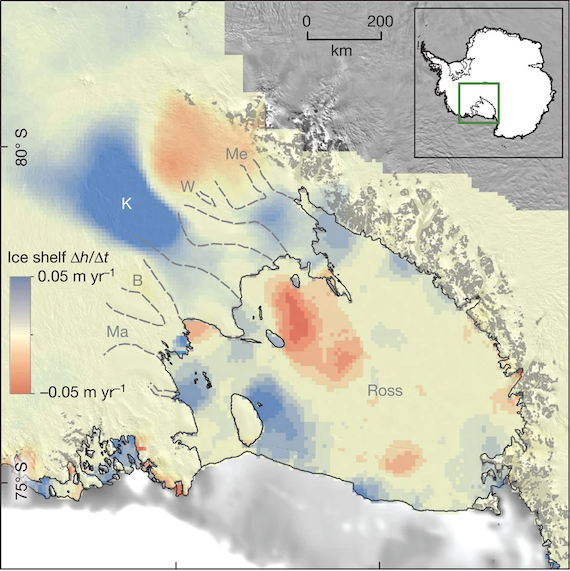 Arguments
Arguments
 Software
Software
 Resources
Comments
Resources
Comments
 The Consensus Project
The Consensus Project
 Translations
Translations
 About
Support
About
Support


Latest Posts
- 2025 SkS Weekly Climate Change & Global Warming News Roundup #51
- Skeptical Science New Research for Week #51 2025
- What are the causes of recent record-high global temperatures?
- Fact brief - Are toxic heavy metals from solar panels posing a threat to human health?
- Emergence vs Detection & Attribution
- 2025 SkS Weekly Climate Change & Global Warming News Roundup #50
- Skeptical Science New Research for Week #50 2025
- The rest of the world is lapping the U.S. in the EV race
- Fact brief - Are electromagnetic fields from solar farms harmful to human health?
- Comparing climate models with observations
- 2025 SkS Weekly Climate Change & Global Warming News Roundup #49
- Skeptical Science New Research for Week #49 2025
- Climate Adam & Dr Gilbz - Paris Climate Agreement At 10: Did It Do Anything?
- Fact brief - Does the recent slowdown in Arctic sea-ice extent loss disprove human-caused warming?
- Why the chemtrail conspiracy theory lingers and grows – and why Tucker Carlson is talking about it
- 2025 SkS Weekly Climate Change & Global Warming News Roundup #48
- Skeptical Science New Research for Week #48 2025
- Consensus machines
- Just have a Think - How an African energy revolution could save ALL of us.
- A girl’s grades drop every summer. There’s an alarming explanation.
- 2025 SkS Weekly Climate Change & Global Warming News Roundup #47
- Fact brief - Are changes in solar activity causing climate change?
- Skeptical Science New Research for Week #47 2025
- Exploring newly released estimates of current policy warming
- Climate Adam - Why the Climate Crisis is a Health Crisis
- Super pollutants are trendy, but we should be careful how we use them
- 2025 SkS Weekly Climate Change & Global Warming News Roundup #46
- Skeptical Science New Research for Week #46 2025
- On the Gates climate memo
- Climate Adam - Climate Scientist responds to Bill Gates
Archived Rebuttal
This is the archived Intermediate rebuttal to the climate myth "Antarctica is gaining ice". Click here to view the latest rebuttal.
What the science says...
|
While the interior of East Antarctica is gaining land ice, overall Antarctica has been losing land ice at an accelerating rate. Antarctic sea ice is growing despite a strongly warming Southern Ocean. |
Antarctica is a continent 98% covered by ice, surrounded by local ocean with much of its surface seasonally covered by sea ice. Reporting on Antarctic ice often fails to recognise the fundamental difference between sea ice and land ice. Antarctic land ice is the ice which has accumulated over thousands of years on the Antarctica landmass through snowfall. This land ice therefore is actually stored ocean water that once evaporated and then fell as precipitation on the land, a fact with implications. Antarctic sea ice is entirely different as it is ice which forms in salt water during the winter and almost entirely melts again in the summer.
The crucial difference: when land ice melts and flows into the oceans global sea levels rise on average, while conversely when sea ice melts, sea levels do not change measurably.
Summarizing the current situation with Antarctic ice trends:
- Antarctic land ice is decreasing at an accelerating rate and is contributing to sea level rise
- Until recently Antarctic sea ice has been increasing despite the warming Southern Ocean and with no effect on sea level
Antarctic Land Ice is decreasing
Measuring changes in Antarctic land ice mass has been a difficult process due to the ice sheet's massive size and complexity. However, since the 1990s the problem has been attacked from multiple directions via multiple methods. The most recent estimate of land ice change that combines estimates from these three approaches reported (IMBIE, 2017) that between 1992 and 2017, the Antarctic Ice Sheets overall lost 2,720 giga-tonnes (Gt) or 2,720,000,000,000 tonnes into the oceans, at an average rate of 108 Gt per year (Gt/yr). Because a reduction in mass of 360 Gt/year represents an annual global-average sea level rise of 1 mm, these estimates equate to an increase in global-average sea levels by 0.3 mm/yr, or 30 mm per decade. Together with the land ice loss from Greenland, this represents about 30% of the observed global-average sea level rise over this period.
Examining how this change is spread over time (Figure 1) reveals that the ice sheet as a whole was not losing or gaining ice in the early 1990s. Since then ice loss has begun, and is clearly seen to have accelerated during that time:
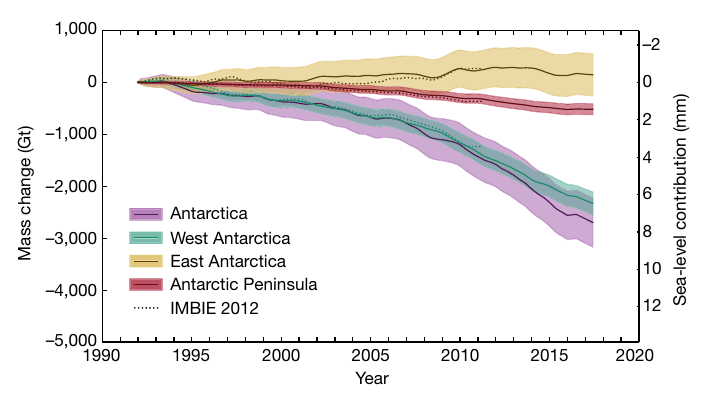
Figure 1: Estimates of total Antarctic land ice changes and approximate sea level contributions using a combination of several different measurement techniques (IMBIE, 2017). Shaded areas represent the estimate uncertainty (1-sigma).
Observational satellites best suited to measuring land ice mass change are of the "gravity recovery" type, orbiting gravimeters that can revisit the same underlying spots on Earth over time (GRACE and GRACE-FO). these instruments can detect changes in Earth's gravity over time with changes mapped to the Earth's surface. Temporal variations in gravitational attraction can be directly related to surface mass variations in such places as the Antarctic ice sheet. GRACE estimates of mass change show an overall accelerating loss ice from the Antarctic, particularly in West Antarctica (Velicogna et al. 2014):
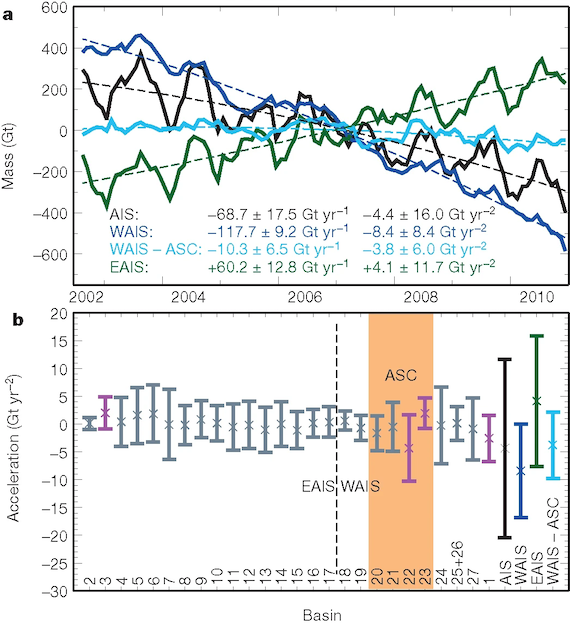
Figure 2: a, GRACE estimate of ice-mass change (2002-2012), with ice drainage basins numbered (boldface italics where trends are statistically different to zero with 95% confidence). b, c, Basin-specific lower and upper bounds on ice-mass change, respectively, reflecting the potential systematic error in the basin estimates (King et al. 2012).
The East Antarctic Ice Sheet has grown slightly over the satellite period (Figures 1&2) but not enough to offset the other losses. It is not yet clear if the regional increase in mass is a short-term phenomena due to a particularly snowy period (Boening et al. 2012) or if it is a long-term trend. Increased snowfall in East Antarctica has long been predicted in a warming climate, so this is an important region to continue monitoring.
The land ice loss from the West Antarctic Ice Sheet is not due to surface melting, as the summer temperatures in Antarctica are generally always below freezing, and measured changes in precipitation cannot explain it either. Instead, the melting is occurring due to warm ocean water melting the land ice around its edges, easing the transport of inland ice to the sea.
Figure 3: Rates of lowering of land ice and its floating extensions in West Antarctica, 2003–2008 (Pritchard et al. 2012). Floating extensions of the land ice (ice shelves) that are labelled are Venable (V), Abbott (A), Cosgrove (C), Pine Island (PI), Thwaites (TH), Crosson (CR), Dotson (D), Getz (G), De Vicq (DV), Land (L), Nickerson (N) and Sulzberger (SZ). Arrows highlight areas of slow-flowing, grounded ice. Bathymetry landward of the continental-shelf break is in greyscale. The divide between floating and grounded ice is shown in white. The inset shows the location of the figure (green box) overlaid on the outline of Antarctica.
The influx in warm water onto the continental shelf in this region is not entirely understood but is probably at least partly linked to increased westerly winds that have occured as a result of reduced stratospheric ozone levels since the mid-20th Century (Gillett & Thompson 2003, Thompson & Solomon 2002, Turner et al. 2009).
The Antarctic ice sheet plays an important role in the total contribution to sea level. That contribution is continuously and rapidly growing.
Antarctic Sea Ice is increasing. Or Is It?
Since the start of satellite observations in 1979 and for many years after, Antarctic sea ice has shown long term growth. This is an observation that has been often cited as proof against global warming. However, rarely is the question raised: why is Antarctic sea ice increasing? The implicit assumption is it must be cooling around Antarctica. This is decidedly not the case. In fact, the Southern Ocean has been warming faster than the rest of the world's oceans. Globally from 1955 to 1995, oceans have been warming at 0.1°C per decade. In contrast, the Southern Ocean has been warming at 0.17°C per decade. Not only is the Southern Ocean warming, it is warming faster than the global trend.
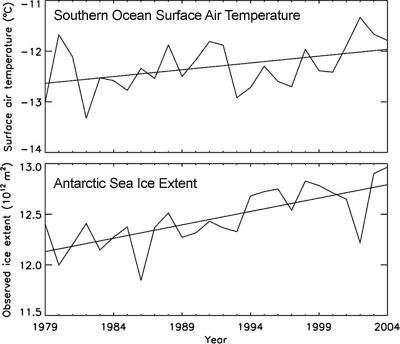
Figure 3: Surface air temperature over the ice-covered areas of the Southern Ocean (top). Sea ice extent, observed by satellite (bottom). (Zhang 2007)
If the Southern Ocean is warming, why is Antarctic sea ice increasing? There are several contributing factors. One is the drop in ozone levels over Antarctica. The hole in the ozone layer above the South Pole has caused cooling in the stratosphere (Gillett & Thompson 2003). This strengthens the cyclonic winds that circle the Antarctic continent (Thompson & Solomon 2002). The wind pushes sea ice around, creating areas of open water known as polynyas. More polynyas lead to increased sea ice production (Turner et al. 2009).
Another contributor is changes in ocean circulation. The Southern Ocean consists of a layer of cold water near the surface and a layer of warmer water below. Water from the warmer layer rises up to the surface, melting sea ice. However, as air temperatures warm, the amount of rain and snowfall also increases. This freshens the surface waters, leading to a surface layer less dense than the saltier, warmer water below. The layers become more stratified and mix less. Less heat is transported upwards from the deeper, warmer layer. Hence less sea ice is melted (Zhang 2007). An increase in melting of Antarctic land ice will also contribute to the increased sea ice production (Bintanja et al. 2013).
As if to underline the various influences controlling Antarctic sea ice, of late the trend of growth has been sharply reversed. Growth may resume, or extent may continue to decrease. In either case, it's not important to the main (and heaviest) message coming to us from Antarctica.
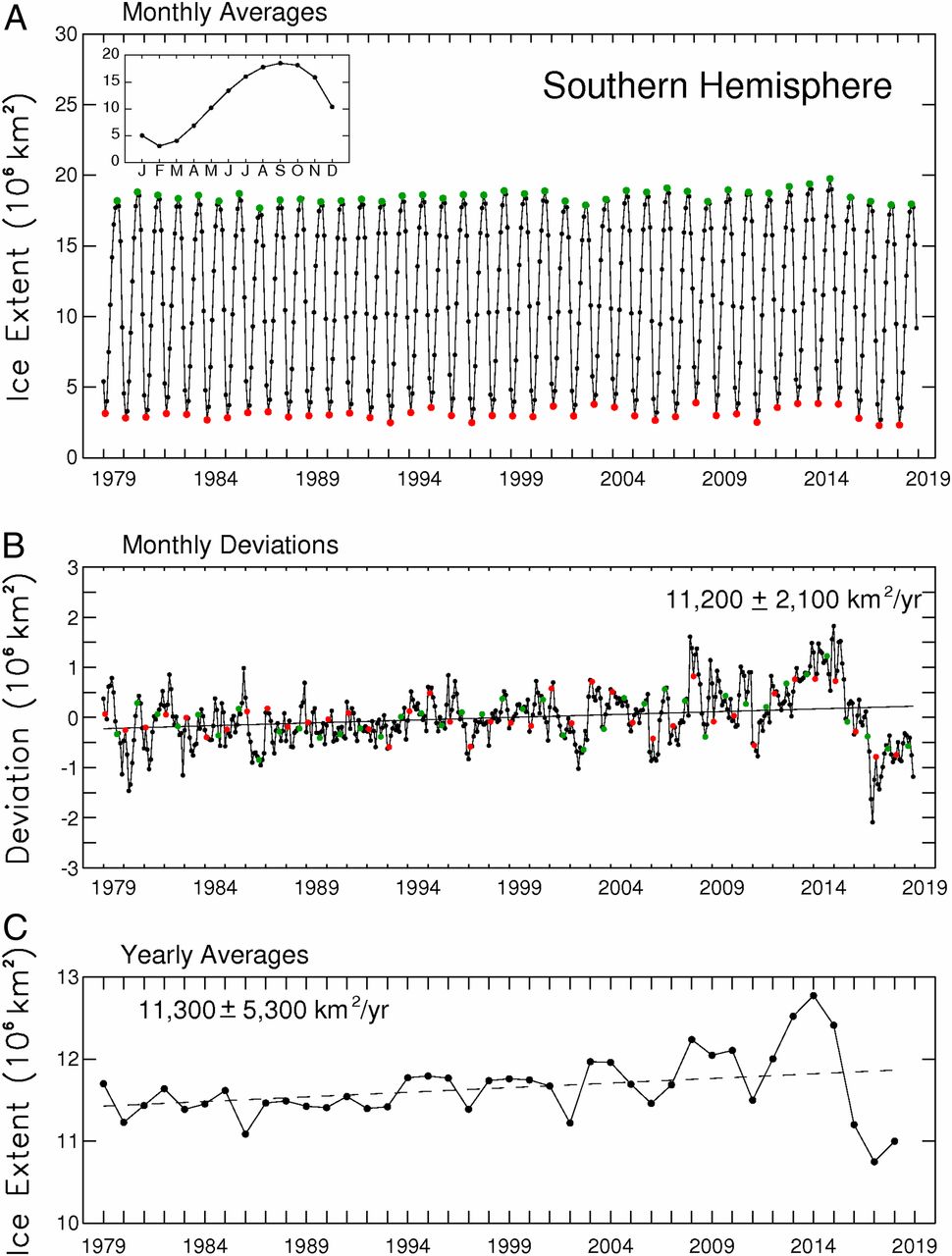
Figure 4: Monthly average sea ice extents for the Southern Hemisphere, January 1979–December 2018. February extents are depicted in red, September extents in green, and all other extents in black. (Inset) The 40-y average annual cycle. Single-letter abbreviations are used for months. (B) Monthly deviations determined from the monthly average data of A, with the same monthly color coding and with the line of linear least squares fit and its slope and SD. (C) Yearly average sea ice extents and their line of linear least squares fit. The ice extents are derived from passive-microwave data from the NASA Nimbus 7 and Department of Defense DMSP satellites (Parkinson, 2019).
In summary, Antarctic sea ice is a complex and unique phenomenon. The simplistic interpretation that it must be cooling around Antarctica is decidedly not the case. Warming is happening - how it affects specific regions is complicated.
Intermediate rebuttal written by mattking
Update July 2015:
Here is a related lecture-video from Denial101x - Making Sense of Climate Science Denial
Additional videos from the MOOC
Interviews with various experts
Expert interview with Jonathan Bamber
Expert interview with Isabella Velicogna
Updated on 2020-01-31 by BaerbelW.
THE ESCALATOR

(free to republish)



















































